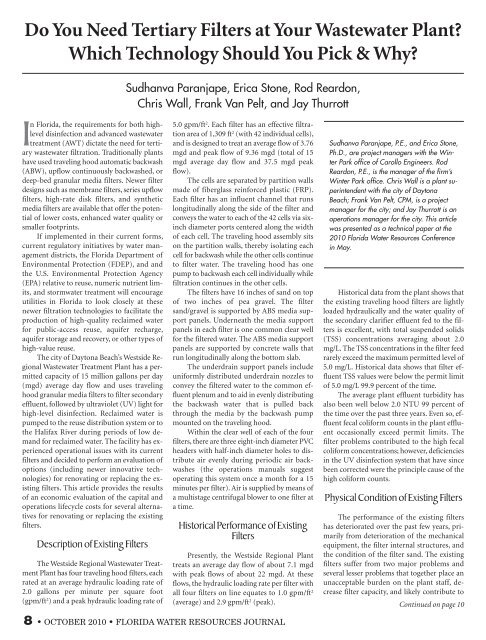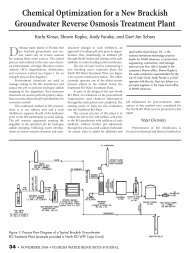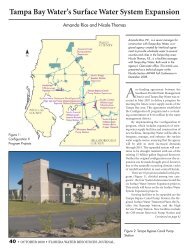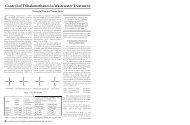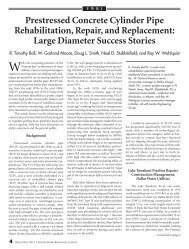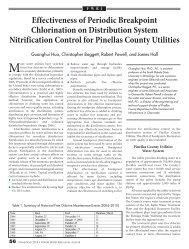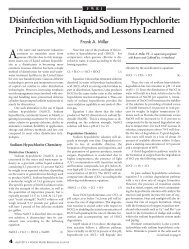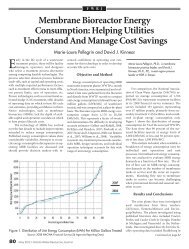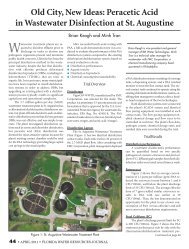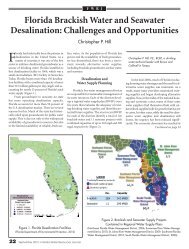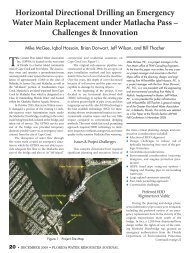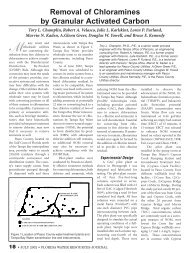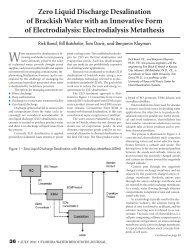Do You Need Tertiary Filters at Your Wastewater Plant? Which ...
Do You Need Tertiary Filters at Your Wastewater Plant? Which ...
Do You Need Tertiary Filters at Your Wastewater Plant? Which ...
Create successful ePaper yourself
Turn your PDF publications into a flip-book with our unique Google optimized e-Paper software.
<strong>Do</strong> <strong>You</strong> <strong>Need</strong> <strong>Tertiary</strong> <strong>Filters</strong> <strong>at</strong> <strong>You</strong>r Wastew<strong>at</strong>er <strong>Plant</strong>?<br />
<strong>Which</strong> Technology Should <strong>You</strong> Pick & Why?<br />
Sudhanva Paranjape, Erica Stone, Rod Reardon,<br />
Chris Wall, Frank Van Pelt, and Jay Thurrott<br />
In Florida, the requirements for both highlevel<br />
disinfection and advanced wastew<strong>at</strong>er<br />
tre<strong>at</strong>ment (AWT) dict<strong>at</strong>e the need for tertiary<br />
wastew<strong>at</strong>er filtr<strong>at</strong>ion. Traditionally plants<br />
have used traveling hood autom<strong>at</strong>ic backwash<br />
(ABW), upflow continuously backwashed, or<br />
deep-bed granular media filters. Newer filter<br />
designs such as membrane filters, series upflow<br />
filters, high-r<strong>at</strong>e disk filters, and synthetic<br />
media filters are available th<strong>at</strong> offer the potential<br />
of lower costs, enhanced w<strong>at</strong>er quality or<br />
smaller footprints.<br />
If implemented in their current forms,<br />
current regul<strong>at</strong>ory initi<strong>at</strong>ives by w<strong>at</strong>er management<br />
districts, the Florida Department of<br />
Environmental Protection (FDEP), and and<br />
the U.S. Environmental Protection Agency<br />
(EPA) rel<strong>at</strong>ive to reuse, numeric nutrient limits,<br />
and stormw<strong>at</strong>er tre<strong>at</strong>ment will encourage<br />
utilities in Florida to look closely <strong>at</strong> these<br />
newer filtr<strong>at</strong>ion technologies to facilit<strong>at</strong>e the<br />
production of high-quality reclaimed w<strong>at</strong>er<br />
for public-access reuse, aquifer recharge,<br />
aquifer storage and recovery, or other types of<br />
high-value reuse.<br />
The city of Daytona Beach’s Westside Regional<br />
Wastew<strong>at</strong>er Tre<strong>at</strong>ment <strong>Plant</strong> has a permitted<br />
capacity of 15 million gallons per day<br />
(mgd) average day flow and uses traveling<br />
hood granular media filters to filter secondary<br />
effluent, followed by ultraviolet (UV) light for<br />
high-level disinfection. Reclaimed w<strong>at</strong>er is<br />
pumped to the reuse distribution system or to<br />
the Halifax River during periods of low demand<br />
for reclaimed w<strong>at</strong>er. The facility has experienced<br />
oper<strong>at</strong>ional issues with its current<br />
filters and decided to perform an evalu<strong>at</strong>ion of<br />
options (including newer innov<strong>at</strong>ive technologies)<br />
for renov<strong>at</strong>ing or replacing the existing<br />
filters. This article provides the results<br />
of an economic evalu<strong>at</strong>ion of the capital and<br />
oper<strong>at</strong>ions lifecycle costs for several altern<strong>at</strong>ives<br />
for renov<strong>at</strong>ing or replacing the existing<br />
filters.<br />
Description of Existing <strong>Filters</strong><br />
The Westside Regional Wastew<strong>at</strong>er Tre<strong>at</strong>ment<br />
<strong>Plant</strong> has four traveling hood filters, each<br />
r<strong>at</strong>ed <strong>at</strong> an average hydraulic loading r<strong>at</strong>e of<br />
2.0 gallons per minute per square foot<br />
(gpm/ft 2 ) and a peak hydraulic loading r<strong>at</strong>e of<br />
5.0 gpm/ft 2 . Each filter has an effective filtr<strong>at</strong>ion<br />
area of 1,309 ft 2 (with 42 individual cells),<br />
and is designed to tre<strong>at</strong> an average flow of 3.76<br />
mgd and peak flow of 9.36 mgd (total of 15<br />
mgd average day flow and 37.5 mgd peak<br />
flow).<br />
The cells are separ<strong>at</strong>ed by partition walls<br />
made of fiberglass reinforced plastic (FRP).<br />
Each filter has an influent channel th<strong>at</strong> runs<br />
longitudinally along the side of the filter and<br />
conveys the w<strong>at</strong>er to each of the 42 cells via sixinch<br />
diameter ports centered along the width<br />
of each cell. The traveling hood assembly sits<br />
on the partition walls, thereby isol<strong>at</strong>ing each<br />
cell for backwash while the other cells continue<br />
to filter w<strong>at</strong>er. The traveling hood has one<br />
pump to backwash each cell individually while<br />
filtr<strong>at</strong>ion continues in the other cells.<br />
The filters have 16 inches of sand on top<br />
of two inches of pea gravel. The filter<br />
sand/gravel is supported by ABS media support<br />
panels. Underne<strong>at</strong>h the media support<br />
panels in each filter is one common clear well<br />
for the filtered w<strong>at</strong>er. The ABS media support<br />
panels are supported by concrete walls th<strong>at</strong><br />
run longitudinally along the bottom slab.<br />
The underdrain support panels include<br />
uniformly distributed underdrain nozzles to<br />
convey the filtered w<strong>at</strong>er to the common effluent<br />
plenum and to aid in evenly distributing<br />
the backwash w<strong>at</strong>er th<strong>at</strong> is pulled back<br />
through the media by the backwash pump<br />
mounted on the traveling hood.<br />
Within the clear well of each of the four<br />
filters, there are three eight-inch diameter PVC<br />
headers with half-inch diameter holes to distribute<br />
air evenly during periodic air backwashes<br />
(the oper<strong>at</strong>ions manuals suggest<br />
oper<strong>at</strong>ing this system once a month for a 15<br />
minutes per filter). Air is supplied by means of<br />
a multistage centrifugal blower to one filter <strong>at</strong><br />
a time.<br />
Historical Performance of Existing<br />
<strong>Filters</strong><br />
Presently, the Westside Regional <strong>Plant</strong><br />
tre<strong>at</strong>s an average day flow of about 7.1 mgd<br />
with peak flows of about 22 mgd. At these<br />
flows, the hydraulic loading r<strong>at</strong>e per filter with<br />
all four filters on line equ<strong>at</strong>es to 1.0 gpm/ft 2<br />
(average) and 2.9 gpm/ft 2 (peak).<br />
Sudhanva Paranjape, P.E., and Erica Stone,<br />
Ph.D., are project managers with the Winter<br />
Park office of Carollo Engineers. Rod<br />
Reardon, P.E., is the manager of the firm’s<br />
Winter Park office. Chris Wall is a plant superintendent<br />
with the city of Daytona<br />
Beach; Frank Van Pelt, CPM, is a project<br />
manager for the city; and Jay Thurrott is an<br />
oper<strong>at</strong>ions manager for the city. This article<br />
was presented as a technical paper <strong>at</strong> the<br />
2010 Florida W<strong>at</strong>er Resources Conference<br />
in May.<br />
Historical d<strong>at</strong>a from the plant shows th<strong>at</strong><br />
the existing traveling hood filters are lightly<br />
loaded hydraulically and the w<strong>at</strong>er quality of<br />
the secondary clarifier effluent fed to the filters<br />
is excellent, with total suspended solids<br />
(TSS) concentr<strong>at</strong>ions averaging about 2.0<br />
mg/L. The TSS concentr<strong>at</strong>ions in the filter feed<br />
rarely exceed the maximum permitted level of<br />
5.0 mg/L. Historical d<strong>at</strong>a shows th<strong>at</strong> filter effluent<br />
TSS values were below the permit limit<br />
of 5.0 mg/L 99.9 percent of the time.<br />
The average plant effluent turbidity has<br />
also been well below 2.0 NTU 99 percent of<br />
the time over the past three years. Even so, effluent<br />
fecal coliform counts in the plant effluent<br />
occasionally exceed permit limits. The<br />
filter problems contributed to the high fecal<br />
coliform concentr<strong>at</strong>ions; however, deficiencies<br />
in the UV disinfection system th<strong>at</strong> have since<br />
been corrected were the principle cause of the<br />
high coliform counts.<br />
Physical Condition of Existing <strong>Filters</strong><br />
The performance of the existing filters<br />
has deterior<strong>at</strong>ed over the past few years, primarily<br />
from deterior<strong>at</strong>ion of the mechanical<br />
equipment, the filter internal structures, and<br />
the condition of the filter sand. The existing<br />
filters suffer from two major problems and<br />
several lesser problems th<strong>at</strong> together place an<br />
unacceptable burden on the plant staff, decrease<br />
filter capacity, and likely contribute to<br />
Continued on page 10<br />
8 • OCTOBER 2010 • FLORIDA WATER RESOURCES JOURNAL
Figure 1. Measured W<strong>at</strong>er Surface Elev<strong>at</strong>ions in Filter No. 4<br />
during the filter load test <strong>at</strong> increased hydraulic loading r<strong>at</strong>es <strong>at</strong> the<br />
Westside Regional Wastew<strong>at</strong>er Tre<strong>at</strong>ment <strong>Plant</strong><br />
Continued from page 8<br />
occasional permit viol<strong>at</strong>ions. The two major<br />
problems are inadequ<strong>at</strong>e backwashing of the<br />
filter sand and deterior<strong>at</strong>ion of the filter components.<br />
There has been failure of most of the FRP<br />
partition walls, allowing short-circuiting during<br />
the backwash process by not allowing the<br />
hood to form a good seal on each filter cell.<br />
Several areas within the filter cells have experienced<br />
a complete loss of filter sand. As a result,<br />
the filter underdrain nozzles in these<br />
loc<strong>at</strong>ions are exposed, allowing direct shortcircuiting<br />
of an unknown amount of the filter<br />
feed into the clear well.<br />
Inadequ<strong>at</strong>e cleaning of the filter sand has<br />
led to high hydraulic head losses and therefore<br />
excessive frequency of backwashing, loss of<br />
sand, and periodic failure of underdrain components.<br />
Lesser problems include leaks in w<strong>at</strong>er<br />
stops and construction joints in the concrete of<br />
the filter structure, problems with the filter<br />
controls th<strong>at</strong> cause unnecessary backwashing,<br />
and minor surface cracks and crevices in the<br />
exterior walls of the filter structure.<br />
Also, the oper<strong>at</strong>ing staff has not used the<br />
periodic air backwash system because of issues<br />
during the filter start-up, during which the<br />
blower system apparently damaged the media<br />
support pl<strong>at</strong>es and the underdrain system.<br />
This air backwash system was eventually fixed<br />
and demonstr<strong>at</strong>ed to oper<strong>at</strong>e well, but the existing<br />
filters <strong>at</strong> the plant oper<strong>at</strong>ed for nearly a<br />
decade with few reported oper<strong>at</strong>ing issues or<br />
permit viol<strong>at</strong>ions. Only within the last couple<br />
of years has the plant experienced recurring<br />
failures of certain components of the filtr<strong>at</strong>ion<br />
system, requiring the plant staff to take filters<br />
off line for repairs while oper<strong>at</strong>ing with only<br />
three filters most of the time.<br />
Performance Testing<br />
of Existing <strong>Filters</strong><br />
To assess the performance of the existing<br />
traveling hood filters, a filter load test was performed.<br />
This test included taking filters off<br />
line sequentially and measuring the head loss<br />
across the filters and w<strong>at</strong>er-quality parameters<br />
<strong>at</strong> the influent and effluent of the filters. Increased<br />
hydraulic loading on the filters resulted<br />
in increased head loss across the filter<br />
and degraded effluent w<strong>at</strong>er quality.<br />
Figure 1 shows a graphical represent<strong>at</strong>ion<br />
of the rising w<strong>at</strong>er-surface elev<strong>at</strong>ions measured<br />
in one of the four filters during a load test<br />
with increasing hydraulic loading r<strong>at</strong>es. As<br />
shown in the figure, the maximum hydraulic<br />
loading r<strong>at</strong>e the filter could handle without<br />
overflowing the scum g<strong>at</strong>e was less than 2.8<br />
gpm/ft 2 . Also, based on current filter oper<strong>at</strong>ing<br />
settings, it takes 112 minutes to backwash<br />
one filter (all 42 cells), so a lag time exists after<br />
a filter reaches maximum head loss until it is<br />
completely cleaned.<br />
Sieve analysis performed on one sample<br />
from one of the filters showed vari<strong>at</strong>ion in the<br />
effective size and uniformity coefficient (U.C.)<br />
for the sand when compared to the original<br />
specific<strong>at</strong>ion per the system manufacturer’s<br />
oper<strong>at</strong>ions and maintenance manual. The effective<br />
size of the current filter sand is slightly<br />
smaller (actual sand has effective size of 0.5<br />
mm and a 90th percentile grain size of about<br />
1.6 mm, compared to the specified effective<br />
size of 0.55 mm) and the grad<strong>at</strong>ion of grain<br />
sizes is less uniform than the sand originally<br />
specified (U.C. of actual sand is 1.7, compared<br />
to a U.C. of 1.5 for specified sand). Use of this<br />
sand increases the head loss through the filter<br />
and the loss of sand during backwashing.<br />
Perhaps the gre<strong>at</strong>est impact of the current<br />
sand characteristics is on the upflow velocity<br />
needed to fluidize the filter bed. Minimum fluidiz<strong>at</strong>ion<br />
velocities correl<strong>at</strong>e with the 90th percentile<br />
sand size, and a 90th percentile size of<br />
1.6 mm should require an upflow velocity of<br />
about 30 gpm/ft 2 . This is significantly higher<br />
than the original design (the design is based<br />
around 16-20 gpm/ft 2 ), and beyond the capacity<br />
of the existing backwash pumps.<br />
Based on the filter load test, it was concluded<br />
th<strong>at</strong> the existing filters, in the as-is condition,<br />
can tre<strong>at</strong> about 20-22 mgd without<br />
overflowing the scum g<strong>at</strong>es and could overflow<br />
the structure when peak flows exceed 28-30<br />
mgd with all four units in service. The filters<br />
do not have a bypass around the structure, and<br />
any rise in the w<strong>at</strong>er surface elev<strong>at</strong>ion because<br />
of filter upsets could result in w<strong>at</strong>er overflowing<br />
the filter structure onto the ground.<br />
Analysis of Filtr<strong>at</strong>ion<br />
System Altern<strong>at</strong>ives<br />
Currently there are several commercially<br />
available proven filtr<strong>at</strong>ion technologies for<br />
wastew<strong>at</strong>er applic<strong>at</strong>ions th<strong>at</strong> can provide a<br />
smaller footprint, less maintenance, more efficient<br />
backwashing, or better effluent quality.<br />
Available filtr<strong>at</strong>ion technologies were reviewed<br />
and eight altern<strong>at</strong>ive methods for renov<strong>at</strong>ing<br />
or replacing the existing filters <strong>at</strong> the Westside<br />
Regional Tre<strong>at</strong>ment <strong>Plant</strong> were selected for detailed<br />
evalu<strong>at</strong>ion.<br />
Technologies were selected th<strong>at</strong> would fit<br />
well within the existing plant processes while<br />
representing a broad spectrum of technologies.<br />
The filtr<strong>at</strong>ion system altern<strong>at</strong>ives selected<br />
for improving the tertiary filtr<strong>at</strong>ion <strong>at</strong> the<br />
plant are:<br />
Altern<strong>at</strong>ive 1: Existing traveling hood filters<br />
repaired/rehabilit<strong>at</strong>ed.<br />
Altern<strong>at</strong>ive 2: New deep-bed granular<br />
media filters.<br />
Altern<strong>at</strong>ive 3: New low-pressure membrane<br />
system using in-vessel pressure membranes.<br />
Altern<strong>at</strong>ive 4: Existing filters retrofitted<br />
with cloth media l<strong>at</strong>erals<br />
Continued on page 12<br />
10 • OCTOBER 2010 • FLORIDA WATER RESOURCES JOURNAL
Continued from page 10<br />
Altern<strong>at</strong>ive 5: New cloth media disk filters.<br />
Altern<strong>at</strong>ive 6: New high-r<strong>at</strong>e disk filters<br />
Altern<strong>at</strong>ive 7: New compressible synthetic<br />
media filters<br />
Altern<strong>at</strong>ive 8: New series, upflow filters<br />
Each filtr<strong>at</strong>ion altern<strong>at</strong>ive was sized to<br />
handle an average flow of 15 mgd and a peak<br />
flow of 45 mgd. Conceptual sizing for each altern<strong>at</strong>ive<br />
approach was based on industry<br />
standard hydraulic loading r<strong>at</strong>es <strong>at</strong> average<br />
and peak conditions. Each altern<strong>at</strong>ive was<br />
sized to be able to tre<strong>at</strong> 75 percent of the peak<br />
hour flow with one unit out of service, thereby<br />
meeting EPA Class 1 reliability criteria.<br />
The following paragraphs briefly describe<br />
each altern<strong>at</strong>ive. In addition, Table 1 presents<br />
the key design characteristics for the eight altern<strong>at</strong>ives<br />
considered in the analysis, while<br />
Table 2 presents the typical removal of particles<br />
and p<strong>at</strong>hogens for the various filter types.<br />
Altern<strong>at</strong>ive 1: Existing traveling hood<br />
filters repaired/rehabilit<strong>at</strong>ed<br />
Under this altern<strong>at</strong>ive, repairs or modific<strong>at</strong>ions,<br />
along with any necessary expansion to<br />
the existing filters, were considered. As pointed<br />
out earlier, the existing filters in their current<br />
condition can tre<strong>at</strong> a peak flow of only about<br />
22 mgd. Figure 1 shows th<strong>at</strong> the existing filters<br />
can not handle flow r<strong>at</strong>es in excess of 2.8<br />
gpm/ft 2 .<br />
Very few regul<strong>at</strong>ory or industry standards<br />
exist for allowable hydraulic loading r<strong>at</strong>es on<br />
traveling type filters. Performance criteria established<br />
by California Recycled W<strong>at</strong>er Criteria<br />
(Title 22) for tertiary filters limits the<br />
hydraulic loading r<strong>at</strong>es to no more than 2.0<br />
gpm/ft 2 in traveling hood autom<strong>at</strong>ic backwash<br />
filters. Taking into consider<strong>at</strong>ion the design<br />
and oper<strong>at</strong>ion of the existing filters and problems<br />
with the filters, the project team recommended<br />
th<strong>at</strong> the existing filters be oper<strong>at</strong>ed <strong>at</strong><br />
hydraulic loading r<strong>at</strong>es of 2.0 gpm/ft 2 or less<br />
<strong>at</strong> peak flow conditions.<br />
At 2.0 gpm/ft 2 , the flow through each filter<br />
will be about 3.8 mgd, and with all four filters<br />
in oper<strong>at</strong>ion, the total capacity of the<br />
existing filters will be about 15 mgd. Increasing<br />
the capacity of the existing filters to provide a<br />
peak flow capacity of 45 mgd will require the<br />
addition of eight filters of the same size as the<br />
existing filters (16 feet wide by 87 feet, 9 inches<br />
long), thus providing a total effective filtr<strong>at</strong>ion<br />
area of 15,708 ft 2 . This altern<strong>at</strong>ive will also require<br />
replacement or refurbishment of the existing<br />
filter equipment and repairs to the<br />
existing containment structure.<br />
Table 1. Key Design Characteristics for the Various Filtr<strong>at</strong>ion Altern<strong>at</strong>ives<br />
Table 2. Typical Removal of Particles and P<strong>at</strong>hogens for Various Types of <strong>Filters</strong><br />
Altern<strong>at</strong>ive 2: New deep-bed granular<br />
media filters<br />
The second altern<strong>at</strong>ive considered was<br />
adding deep-bed granular media filters to replace<br />
the existing autom<strong>at</strong>ic backwash traveling<br />
hood filters. Deep-bed filters are installed<br />
<strong>at</strong> the city’s other facility, Bethune Point<br />
Wastew<strong>at</strong>er Tre<strong>at</strong>ment <strong>Plant</strong>, and hence would<br />
provide similarity in the equipment between<br />
the two plants.<br />
This design was based on a maximum hydraulic<br />
loading r<strong>at</strong>e of 5.5 gpm/ft 2 with clarified<br />
secondary effluent with an influent TSS<br />
concentr<strong>at</strong>ion of 20 mg/l or less. With all units<br />
in service, the hydraulic loading r<strong>at</strong>e <strong>at</strong> peak<br />
flow of 45 mgd would be 5.6 gpm/ft 2 . With one<br />
μ<br />
unit out of service, the filters would be able to<br />
tre<strong>at</strong> 75 percent of the peak flow (33.75 mgd)<br />
<strong>at</strong> a hydraulic loading r<strong>at</strong>e of 4.9 gpm/ft 2 .<br />
Intermedi<strong>at</strong>e pumping for clarifier effluent<br />
will be required to make this system fit<br />
within the existing hydraulic profile for the facility.<br />
This analysis assumed the construction<br />
of a new submersible pump st<strong>at</strong>ion.<br />
Altern<strong>at</strong>ive 3: New low-pressure<br />
membrane system<br />
Continued on page 14<br />
12 • OCTOBER 2010 • FLORIDA WATER RESOURCES JOURNAL
Table 3. Engineer’s Estim<strong>at</strong>e of Total Net Present Worth<br />
1 reliability.<br />
Based on preliminary hydraulic calcul<strong>at</strong>ions,<br />
no intermedi<strong>at</strong>e pumping would be necessary<br />
to add the disk filters between the<br />
existing clarifiers and the subsequent UV disinfection<br />
system.<br />
costs for the Filtr<strong>at</strong>ion Altern<strong>at</strong>ives Evalu<strong>at</strong>ed (1) Continued on page 16<br />
Continued from page 12<br />
For this altern<strong>at</strong>ive, a pressurized in-vessel<br />
membrane filter system was chosen as a<br />
typical example of a tertiary low-pressure<br />
membrane filter. The design was based on an<br />
oper<strong>at</strong>ional flux of 40 gfd (gallons per day per<br />
ft 2 ) and a recovery of 90 percent. A total of 20<br />
trains or racks would be required.<br />
A 400-micron inline, self-cleaning<br />
strainer installed upstream from the membrane<br />
racks would protect the membranes<br />
from large particul<strong>at</strong>e m<strong>at</strong>ter. The evalu<strong>at</strong>ion<br />
assumed the membrane system would be enclosed<br />
inside a concrete masonry unit (CMU)<br />
block building (116 feet by 110 feet, > 12,800<br />
ft2). Clarifier effluent would be pumped to the<br />
membrane system via a new submersible<br />
pump st<strong>at</strong>ion.<br />
Altern<strong>at</strong>ive 4: Retrofit existing filters<br />
with cloth media l<strong>at</strong>erals<br />
Replacing the existing filters with cloth<br />
media l<strong>at</strong>erals would require similar repairs to<br />
the concrete structure as in Altern<strong>at</strong>ive 1 to<br />
stop any leaks. All existing filter components<br />
would be removed and the floor of the existing<br />
filters would be rehabilit<strong>at</strong>ed and leveled for<br />
placement of the cloth media l<strong>at</strong>erals and all<br />
required filter components.<br />
Three of the existing filters would be<br />
retrofitted with six diamond-shaped cloth<br />
media l<strong>at</strong>erals in each filter. A new traveling<br />
hood equipped with backwash pump, vacuum<br />
valves and other components would travel<br />
longitudinally, similar to the existing hood, to<br />
clean the l<strong>at</strong>erals <strong>at</strong> a preset head loss or w<strong>at</strong>er<br />
level. The l<strong>at</strong>erals would be approxim<strong>at</strong>ely 32<br />
inches high and 80 feet long.<br />
The total surface area for the 18 diamonds<br />
to be installed would be 5,515 ft 2 . This<br />
would provide a hydraulic loading r<strong>at</strong>e of 5.6<br />
gpm/ft 2 <strong>at</strong> the peak flow of 45 mgd. With one<br />
filter out of service (six l<strong>at</strong>erals) the effective<br />
surface area would be reduced to 3,676 ft 2 and<br />
the hydraulic loading r<strong>at</strong>e would be 6.4 gpm/<br />
ft 2 <strong>at</strong> the flow r<strong>at</strong>e of 33.75 mgd, meeting Class<br />
1 reliability. This altern<strong>at</strong>ive would not require<br />
any intermedi<strong>at</strong>e pumping as the new l<strong>at</strong>erals<br />
would be retrofitted within the existing concrete<br />
structure.<br />
Altern<strong>at</strong>ive 5: New cloth media disk filters<br />
Under this altern<strong>at</strong>ive, new cloth media<br />
disk filters would be constructed and the existing<br />
ABW filters would be taken offline. Each<br />
disk filter unit would include 12 disks with an<br />
effective filter area of 645.5 ft 2 .<br />
A total of eight units are required to provide<br />
a total effective filter area of 5,165 ft 2 to<br />
tre<strong>at</strong> the peak flow of 45 mgd. This would<br />
provide a hydraulic loading r<strong>at</strong>e of 6.05<br />
gpm/ft 2 <strong>at</strong> the peak flow of 45 mgd. With one<br />
entire filter out of service, the effective surface<br />
area would be reduced to 4,518 ft2 and the hydraulic<br />
loading r<strong>at</strong>e would be 5.2 gpm/ft 2 <strong>at</strong><br />
the flow r<strong>at</strong>e of 33.75 mgd meeting the Class<br />
Altern<strong>at</strong>ive 6: New high r<strong>at</strong>e disk filters<br />
Under this altern<strong>at</strong>ive, the existing filters<br />
would be replaced with new micro- media disk<br />
filters. Each filter has a total of 24 disks with<br />
530 ft 2 of dynamic filtr<strong>at</strong>ion area.<br />
The major difference between the microscreen<br />
disk filters and the other disk filters is<br />
th<strong>at</strong> the disks are always rot<strong>at</strong>ing, and are fed <strong>at</strong><br />
angles less than 90º. This is the basis for “dynamic<br />
tangential filtr<strong>at</strong>ion.” The flow p<strong>at</strong>tern is<br />
“inside-out” with the feed passing through the<br />
filter mesh and freely falling into a filtr<strong>at</strong>e zone<br />
below and flowing out of the unit.<br />
If <strong>at</strong> any time the level in the feed zone<br />
rises above a pre-set limit, a level sensor initi<strong>at</strong>es<br />
oper<strong>at</strong>ion of the wash w<strong>at</strong>er pump and the<br />
back of the screen mesh is sprayed by lowpressure<br />
w<strong>at</strong>er between 20 and 60 psig w<strong>at</strong>er<br />
for typically 5-10 seconds. The target filtr<strong>at</strong>ion<br />
r<strong>at</strong>e for this filter is 16 gpm/ft 2 , compared to<br />
the 6.5 gpm/ft 2 for cloth media filters described<br />
above; therefore, for this applic<strong>at</strong>ion a<br />
total of four units with a total filtr<strong>at</strong>ion area of<br />
2,120 ft 2 would be required. This would provide<br />
a hydraulic loading r<strong>at</strong>e of 4.92 gpm/ft 2 <strong>at</strong><br />
the average flow of 15 mgd.<br />
With one entire filter out of service, the<br />
effective surface area would be reduced to<br />
1,590 ft 2 and the hydraulic loading r<strong>at</strong>e will be<br />
14.75 gpm/ft 2 <strong>at</strong> the flow r<strong>at</strong>e of 33.75 mgd<br />
meeting the Class 1 reliability. Similar to Altern<strong>at</strong>ive<br />
5, no intermedi<strong>at</strong>e pumping would<br />
be necessary between the existing clarifiers and<br />
the subsequent UV disinfection system.<br />
Altern<strong>at</strong>ive 7: New compressible<br />
synthetic media filters<br />
This filtr<strong>at</strong>ion system is a high-r<strong>at</strong>e, upflow<br />
system th<strong>at</strong> uses compressible, synthetic<br />
fiber spheres as the medium for filtr<strong>at</strong>ion. A<br />
standard system includes painted steel vessels,<br />
galvanized steel internals, an air supply for<br />
backwashing the filter media, and PLC controls.<br />
Media is held in place between a fixed<br />
lower perfor<strong>at</strong>ed pl<strong>at</strong>e and an upper moveable<br />
perfor<strong>at</strong>ed pl<strong>at</strong>e. The target filtr<strong>at</strong>ion r<strong>at</strong>e for<br />
this system is 30 gpm/ft 2 . A total of 21 units,<br />
each with a foot print size of 49 ft 2 would be<br />
required. The units would have a maximum<br />
oper<strong>at</strong>ing height of 22.5 feet. Intermedi<strong>at</strong>e<br />
pumping of clarifier effluent would be required<br />
to fit this system within the existing hydraulic<br />
profile of the facility.<br />
14 • OCTOBER 2010 • FLORIDA WATER RESOURCES JOURNAL
Table 4 .Weight and Scores for Economic and Various Non-Economic Criteria<br />
for the Filtr<strong>at</strong>ion System Altern<strong>at</strong>ives Evalu<strong>at</strong>ed<br />
For each altern<strong>at</strong>ive, capital and annual<br />
oper<strong>at</strong>ion and maintenance costs were estim<strong>at</strong>ed<br />
and a net present worth value was calcul<strong>at</strong>ed,<br />
assuming a 20-year oper<strong>at</strong>ing period.<br />
The results of the economic evalu<strong>at</strong>ion are<br />
presented in Table 3.<br />
Continued from page 14<br />
Altern<strong>at</strong>ive 8: New series upflow filters<br />
Under this altern<strong>at</strong>ive, the existing filters<br />
will be replaced with a new continuous backwash<br />
series upflow filter system. Each module<br />
consists of two continuously self-cleaning sand<br />
filters in series. Each sand filter is designed to<br />
serve a different function within the process.<br />
The first-stage filter uses larger sand grain<br />
size to give it more solids handling capacity. In<br />
this stage, coagul<strong>at</strong>ion, floccul<strong>at</strong>ion, and separ<strong>at</strong>ion<br />
take place within the filter bed. The second<br />
unit acts as a polishing filter, using a<br />
smaller sand size and providing higher removal<br />
efficiencies.<br />
The third component of the system is a<br />
gravity settler, which tre<strong>at</strong>s reject from both<br />
filter stages. Average reject effluent volume is<br />
0.5 percent of the feed flow.<br />
For the Westside Regional Tre<strong>at</strong>ment<br />
<strong>Plant</strong> applic<strong>at</strong>ion, a total of 11 filter cells for<br />
each stage (total of 22 filter cells) would be required,<br />
providing a total filtr<strong>at</strong>ion area of<br />
13,200 ft 2 . With one filter cell out of service<br />
from each of the two stages, the effective filtr<strong>at</strong>ion<br />
area would be reduced to 12,000 ft 2 and<br />
the hydraulic loading r<strong>at</strong>e would be about 4<br />
gpm/ft 2 <strong>at</strong> the flow r<strong>at</strong>e of 33.75 mgd meeting<br />
Class 1 reliability.<br />
Economic Analysis for Altern<strong>at</strong>ives<br />
Ranking of Filtr<strong>at</strong>ion Altern<strong>at</strong>ives<br />
The altern<strong>at</strong>ives were compared using both<br />
economic and non-economic parameters, and<br />
a weighted evalu<strong>at</strong>ion m<strong>at</strong>rix was cre<strong>at</strong>ed ranking<br />
the altern<strong>at</strong>ives. Only the top five altern<strong>at</strong>ives<br />
were considered for the ranking analysis.<br />
A list of key characteristics or criteria th<strong>at</strong><br />
might influence the choice of a filtr<strong>at</strong>ion system<br />
was identified. Each evalu<strong>at</strong>ion criterion was assigned<br />
a subjective weight from 1 to 5, based on<br />
the perceived overall significance of the criterion<br />
to the project. The criteria with the most<br />
significance received a weight of 5 and those<br />
with the least significance received a weight of 1.<br />
Each altern<strong>at</strong>ive was individually scored<br />
for each criterion on a scale of 1 to 5, depending<br />
on how the altern<strong>at</strong>ive was judged to perform<br />
rel<strong>at</strong>ive to th<strong>at</strong> criterion, with 1 being the<br />
least favorable score and 5 being the most favorable<br />
score.<br />
The estim<strong>at</strong>es for capital and oper<strong>at</strong>ing<br />
costs, land area, and power consumption were<br />
converted to a numeric score, based on a linear<br />
interpol<strong>at</strong>ion between the lowest estim<strong>at</strong>e and<br />
the highest estim<strong>at</strong>e. Other qualit<strong>at</strong>ive criteria<br />
were scored based on a combin<strong>at</strong>ion of published<br />
past performance d<strong>at</strong>a and the subjective<br />
opinion of the project team with input<br />
from the city staff. The numeric scores for<br />
these criteria were then included in the m<strong>at</strong>rix<br />
scoring table.<br />
For each altern<strong>at</strong>ive, the score for each<br />
criterion was then multiplied by the criterion<br />
weight and multiplic<strong>at</strong>ion products were<br />
summed to obtain the overall score for the altern<strong>at</strong>ive.<br />
The best altern<strong>at</strong>ive is the one with<br />
the highest score. Table 4 presents the summary<br />
of the ranking analysis.<br />
Conclusions<br />
From the work done for this study, three<br />
feasible altern<strong>at</strong>ives for replacing the existing<br />
filtr<strong>at</strong>ion system were identified. These are<br />
deep bed filters, cloth l<strong>at</strong>eral filters, and cloth<br />
disk filters. Based on the weighted m<strong>at</strong>rix evalu<strong>at</strong>ion<br />
performed, deep-bed filters are the preferred<br />
altern<strong>at</strong>ive; however, there was not a<br />
significant difference between the three top<br />
ranked altern<strong>at</strong>ives.<br />
From a capital cost standpoint alone, the<br />
altern<strong>at</strong>ive to retrofit the existing filter structures<br />
with cloth media l<strong>at</strong>erals (Altern<strong>at</strong>ive 4)<br />
is the least expensive, followed by the deep-bed<br />
filters (Altern<strong>at</strong>ive 2). The high-r<strong>at</strong>e disk filters<br />
(Altern<strong>at</strong>ive 6) also offer an economical option;<br />
however, it was not considered in the detailed<br />
evalu<strong>at</strong>ion.<br />
<br />
16 • OCTOBER 2010 • FLORIDA WATER RESOURCES JOURNAL


